A feline needs to explore the great outdoors, fresh air, enrichment, games and to make friends with the local cat community. However, the outside can pose a threat with various potential hazards that risk their health and safety.
Cats are naturally independent and curious. There are top outdoor risks and hazards which I am identifying in this article, and from experience can offer ways to keep them safe, but as a cat owner myself, it will never be fail-proof. Cats are independent creatures and free-roaming; however much you try to protect them, accidents, death, ongoing veterinary treatment and the emotional impact can happen. Implementing different methods may save you from the loss, financial implications, or your cat’s illness or trauma.
Let’s explore my selection of common dangers for cats (including strays) outdoors.

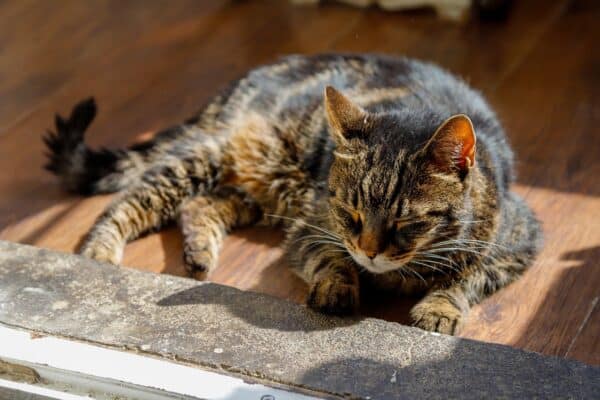


Table of Contents:
- Road Traffic Accident – which environments have been identified as the highest RTAs?
- Predators
- Plants, herbs and shrubs
- Pesticides
- Ticks and fleas
- Poisonous substances
- Water
- Extreme temperatures
- Hayfever
- Injury from a catfight
- Outdoor buildings
1 – Traffic and areas
Under the Road Traffic Act (1988), reporting an accident with a cat is not a legal requirement, although it is being debated in Parliament.
Bristol Cat Study followed the early lives of 1000 cats from 8 weeks to 12 months. The misconception is that death happens mainly in busy, urban areas. The reality in the findings presented, cats living in rural locations are at a higher risk. Despite this, more accidents happened on long straight roads than on other roads. Furthermore, the study found that a cat’s personality and response to traffic were significant too.
How does your cat respond to traffic?
- Confidently
- Runs off in fright
- Have limited awareness of traffic for any particular reason
Bristol Cat Study – 2021
Cat owners completed three questionnaires regarding their feline’s age and outdoor access. The breakdown of age for each questionnaire is as follows –
A: 8 to 16 weeks
B: 6 months
C: 12 months
The findings from Bristol Cat Study regarding an RTA are below:
| Location | Statistics |
|---|---|
| Rural cats more likely compared cats in urban areas | 2.66 times |
| Cats living by long straight roads compared to cats that didn’t | 2.84 times |
| Cats hunting beside the road compared to those that didn’t | 3.30 times |
| Cats aged up to 12 months but RTA occurred around 6 months old | 3.9% |
| Injuries were non-fatal but veterinary treatment needed for serious injuries | 17% |
| Fatal | 74% |
We can assume cats living in rural areas are not road-savvy because of less traffic and depending on the region, whether roads are long and straight. An example of this type of road system is the Fenland area. The study further showed that deaths were not determined by coat colour, whether neutered (un-neutered cats are always believed to be at risk because of the extent of roaming), black cats at night or sex.
Both my cats lost their lives on a road – one on a straight dead-end road. And the other was a dead-end, short, windy country lane that you could not speed along because set within a cluster of houses and parked cars. RTA’s tend to be at night but mine died during the day. It shows that traffic accidents can occur anywhere, not just at night.
Muffin died when a speeding van hit him in a housing estate. Dixie died close to my home in a rural village. As a hyperactive feline, we can only assume she dashed along our private access drive, out onto the winding, narrow, dead-end lane and collided with a vehicle. A high fence to one side and a house to the other prevented visibility for the driver but as a 2 year old cat, Dixie was daring and fast too. Both incidents were quick and they died from head trauma.
Helping to keep your cat safe outdoors:
- Encourage your cat to come in before sunset by offering dinner. This is the routine I had with my cats in the end. Cats go into hunting mode as the sun sets
- Lock cat flaps at night or use a time-controlled one. Cat Mate’s microchip cat flap is the cheapest I can find. It is suitable for up to 9 cats, but I like it because it has a ‘last used’ option for 3 cats. That gives of mind, especially in the warmer months when tracking them
- Regardless of a cat wearing a reflective collar, this won’t prevent a car from stopping in time
- Living in a speed-restricted area does not mean drivers obey
- Cat-proofing the garden or installing a catio can help keep your car safe
- Get a notification from a GPS cat tracker because your cat has breached a virtual fence
2 – Predators
High-prey dogs can present a danger to cats and cats cannot always outrun dogs known for speed. Dogs that are not high prey but naturally chase any animal may cause a cat to run toward a road.
I have often read social media posts about foxes being a threat to cats. Experts say foxes may carry their young in their mouths and can be mistaken for carrying a cat. They also say cats are not in danger, mainly due to being similar in size to a fox; however, a tiny kitten may be in danger of being killed.
Helping to keep your cat safe outdoors:
- Cat-proofing your garden or installing a catio will keep your pet safe
- From experience, a confident cat may take chances if a neighbour has high-prey dogs and visit the garden when the dogs aren’t around (eg greyhounds)
3 – Plants, herbs & shrubs
Many outdoor plants are toxic to cats, the Lilly being the most dangerous. As you’ll see from Cats Protection, there is a list of highly toxic plants, and herbs, shrubs and plants to be cautious of.
Cats will probably munch on ornamental or wild grasses (Tabitha does). Felines are careful with what they consume, so they are more likely to come in contact with poison when they brush against or walk on something toxic. A cat will later wash itself and ingest it. As a cat owner, looking out for physical signs that your cat is unwell is necessary because felines are known for hiding ill health.
Signs your cat may have been poisoned:
- Vomiting
- Diarrhoea
- Tremors
- Confusion
- Depression
- Seizures
- Coma
- Collapse
Helping to keep your cat safe outdoors:
You can create a cat-safe garden but you’ll never stop your feline from wandering into other people’s gardens. To keep your cat safe, it’s back to the catio or cat-proofing the garden-it’s the only way to 100% keep your cat safe. Alternatively, if your feline is free to roam, check fur and paws regularly when it comes home and wipe clean if needed.
Visit Cats Protection for advice on a cat-friendly (and bird safe) garden.
4 – Pesticides
The following pesticides are toxic, and it is vital to ensure bottles aren’t leaking and products stored on high shelves cannot topple off when a curious feline decides to explore. To keep a feline (and children) safe, lock dangerous pesticides and chemicals in a store cupboard.
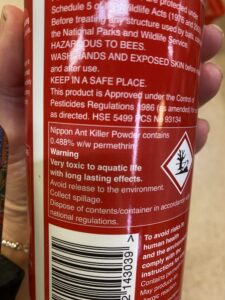
Again, cats can walk on and brush pass poisons in the garden, and cleaning themselves will ingest any toxins.
- Metaldehyde and Methiocarb are bait for slugs and snails. Surprisingly, cats will eat slug pellets
- Thiophanage-Methyl and Benomyl are used to treat fungal infections
- Rodenticides are rat and mouse killers that are highly toxic for cats. Quantities must be correct if using Brodifacoum, Coumatetrayl, Chlorphacione and Difenacoum sprays; I believe these are safer, but keep cats away from an affected area until the liquid has dried
- Insecticides are pest and bug killers and are toxic to cats
- Permethrin is used in spot-on products for dogs in the fight against fleas. You’ll find it in household flea killer sprays, carpet powder flea killers and some ant powders too. Cats will be poisoned if owners use dog flea products on their felines, and the Permethrin will absorb through the skin. If sprinkling the carpet with flea-killer powder, or spraying the air, keep your cat out of the room. Eventually, hoover the carpet and open windows to allow fresh air in. I would not take a risk with household products containing Permethrin, but if your cat has walked across a carpet with Permethrin powder on it, bathe your cat as suggested by my vet.
Signs that your cat has been poisoned:
Watch the Video: Warning – upsetting content. Permethrin poisoning by International Cat Care
- Vomiting
- Diarrhoea
- Tremors
- Seizures
- Drooling
My cat PJ went missing overnight. I found him lying in the undergrowth on the edge of a field adjacent to a house. The cause of his sudden death is unknown but I always suspected he’d come into contact with rat poison or eaten prey killed by poison that evening. However, it can take 1 to 4 days before any signs so if rat poisoning was the cause, it happened days before without any visible signs. The other culprit was the toilet cleaner – I caught him with his head in the toilet bowl but believed I had caught him in time. There weren’t any identifying bleach burns around his mouth.
Joey vomited a yellow liquid and the vet asked me to bring him in as they suspected poison. He hadn’t ingested poison but had pancreatitis.
Helping to keep your cat safe outdoors:
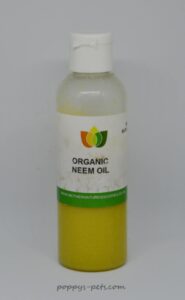
Organic neem oil makes a pet-friendly household flea spray and insecticide for indoor or outdoor plants. Make a small amount in a spray bottle and dilute it with hot water. Never put neat neem oil on pets. Contents not used will eventually go solid as it cools.
Salt is a slug killer but I’ve never tried it with snails, but coffee grounds or crushed eggshells (or sea shells) sprinkled around plants is recommended. Or buy copper tape from Wilko. Opt for humane mouse and rat traps from the Big Cheese. It can take a few days to tempt a mouse into a trap though – my sister uses one in her garage.
Again, you won’t prevent every danger if your cat roams freely.
Indoors, keep the loo lid closed when using toxic cleaners.
5 – Ticks and fleas can be prevented
Fleas, a parasite, is common and cat owners can apply preventive treatments to the back of a cat’s neck. Fleas can be life-threatening in a kitten and a senior cat in poor health so veterinary help may be required. Fleas are a nightmare for a cat; they are uncomfortable, causing itchy skin and continuous scratching, and for some cats, a flea allergy. Joey lost fur and his skin became scally-at the time, Frontline anti-flea treatment didn’t work for him and I had to change brands.
Ticks live outside in natural areas and although active throughout the year, the parasite is more prominent in the spring and autumn. All your cat has to do is brush past one and it can climb or fall onto your cat.
The parasite will feed off your cat by sucking its blood, eventually growing in size- the more ticks, the more dangerous it is for your cat’s health. Lyme Disease is attributed to a tick infestation, a serious bacterial infection and zoonotic (humans can contract Lyme disease). Veterinary intervention is required and treatment is a course of antibiotics leading to a successful recovery.
A vet noticed a tick hidden beneath Joey’s chin and used a tick removal tool to remove the parasite by turning the tool slowly and carefully. Never squeeze or pull the tick’s body or you may leave the body inside your cat.
Helping to keep your cat safe outdoors:
- Only use cat products designed for felines
- Dog flea and tick treatment are fatal for a cat
- Tick and flea treatments are FREE under the Pet Health Club
- Subscribe monthly to preventative treatments from ItchPet and get the first box FREE, and get ongoing FREE access to a Video Vet
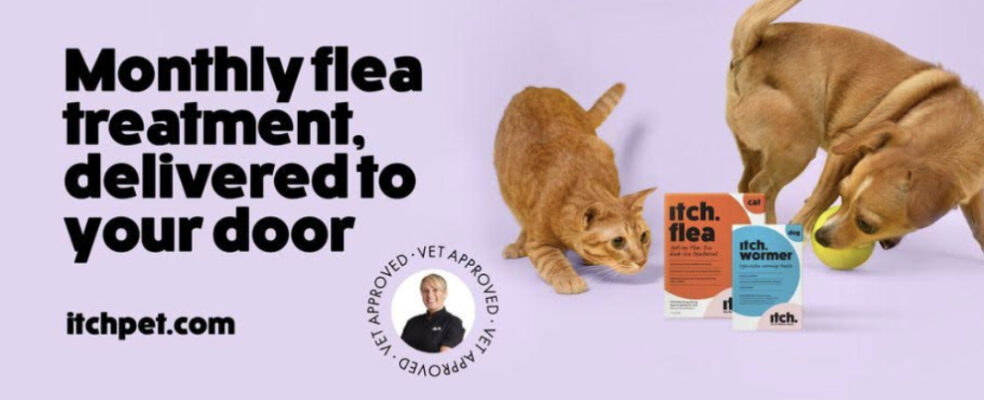
Related articles:
- 9 Toxic food and drinks that are dangerous for dogs
- Heatstroke in cats
- 13 Things to think of before bringing a kitten home (to be updated 2023)
- Home, pet & cleaning hacks
6 – Poisonous substances
Ethylene Glycol, or anti-freeze, is a winter killer for a cat because of its high toxicity. Plastic bottles may perforate and leak, spill into puddles, or be left as poison on purpose. Anti-freeze contains a fluorescent dye so a vet can examine your pet by shining a light beneath the tail and on the paws to see if there is evidence.
Signs of anti-freeze poisoning in cats in the first thirty minutes to 12 hours:
- Vomiting
- Seizures
- Breathing difficulties
- More sleepy than normal
- Depression so less interactive than normal
- Loss of coordination
Anti-freeze poisoning after 2 to 3 days:
- Signs of kidney failure
Rock salt is used to de-ice the roads and paths in the winter and can also be purchased for home use. Rock salt contains Sodium Chloride (salt) and grit; any animal will try to remove an irritant from fur or paw pads by licking. The toxicity level of rock salt is unknown but a small quantity is still very dangerous.
Signs of rock salt poisoning in cats because of the high blood sodium concentrate:
- Vomiting
- Lethargy
- Excessive thirst
- Convulsions
- Kidney damage
Signs of poisoning from varnish and paints:
Latex, a water-based paint, contains low levels of anti-freeze and if ingested or the fumes are inhaled, your cat is at risk of toxicity and should be treated with the same urgency as anti-freeze poisoning. Acrylic, poster paints, and tempera are all water-based and may only cause skin irritation and gastrointestinal problems, but inhaling fumes can cause respiratory issues and eye irritation.
If your cat has ingested these substances, contact your vet urgently.
Helping to keep your cat safe outdoors:
Unfortunately, you will never stop your cat from drinking from a puddle when wandering, walking across rock salt scattered in public areas, or from a neighbour discarding paint pots in the garden. Instead, keep checking on your cat for signs of ill health.
Check paws for rock salt and wipe clean depending on your cat’s personality and tolerance level. Protect your environment and your cat by cleaning up anti-freeze spillages, safely storing containers away from pet areas, and disposing of anti-freeze at your household recycling centre as a hazardous liquid.
Instead of sprinkling rock salt on your pathway at home, use cheap cat litter to create a non-slippery surface to walk on.
7 – Water sources that contain toxins or other risks
How can a cat be harmed by the following?
- Blue-green algae
- Anti-freeze (Ethylene Glycol)
- Drowning
- Hose water
Cyanobacteria, blue-green algae, is extremely poisonous to cats, dogs, wildlife, horses and humans. Even fish! Cyanobacteria is a collection of organisms that cause toxicity – it doesn’t matter if animals are swimming, paddling or drinking in non-flowing water sources (stream, river, lake, fresh) contaminated with the toxin, blue-green algae can be fatal. It is noticeable from its collection of blue-green algae on the water surface but only if present clump form. Regardless of whether you can see it or not, cyanobacteria are highly toxic and more prominent during hot months but can appear in cooler times.
Warning signs of cyanobacteria present:
- Clumps of blue-green algae scum on the water surface
- Foam will appear around the edge of ponds and lakes
- In a lake or stream, look for a green or black substance in a pond
- Dead fish by a lake or pond
We are all urged to leave water bowls out for wildlife and stray animals but these communal water bowls, often dirty, can harbour parasites, bacteria and viruses.
We also see social media Reels of owners playing with dogs and a garden hose. Filling your cat or dog’s outside water bowl (or playing games) is harmful because a garden water hose can harbour bacteria and mould and contain toxic chemicals.
But drinking water with dangerous toxins, bacteria and risk of infection isn’t the only threat. A cat can drown by falling into an open water butt or on a flexible swimming pool cover. Kittens can climb into paddling pools and be unable to climb out.
Helping to keep your cat safe outdoors:
Hydration is vital for any animal outdoors, especially during the hotter days and nights. Clean outdoor drinking bowls daily but you’ll never stop rodents or birds using the same bowl. Cats roam and will find water sources in other places. It isn’t easy to monitor a free-roaming cat, so keep an eye on your cat’s health.
8 – Extreme temperatures
Cats can become dehydrated, overheat and collapse from heat exhaustion. Felines will find cooler places beneath bushes and hide while it’s hot. Evenso, provide shade with plants or a shelter in a cat-proofed garden, a catio, or standard garden and plenty of fresh water cooled with ice cubes.
Cats with free access to the outside using a standard cat flap, or let out in the morning and stay outdoors until their owner comes home from work, must have enough water to keep them hydrated and shade in the garden to protect them from the sun.
Help the strays by providing fresh, clean water daily during the warm weather.
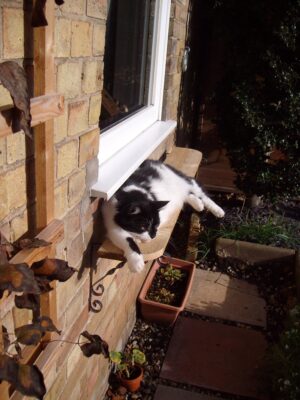
But some cats love to lay in the sun, so watch for signs of heat exhaustion. One sign of is panting.
Watch the Video: Extreme temperatures – heatwave 2022
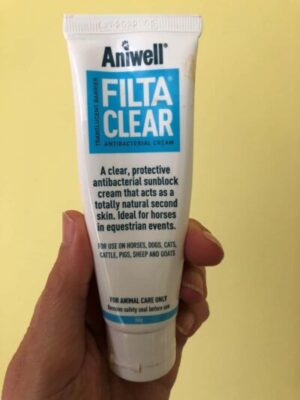
Cats can get sunburn – even in areas with little fur from overgrooming and sunscreen should be applied here.
Apply pet-friendly sunscreen to all exposed areas: a cat’s nose, ear tips, belly, and groin.
Never use human sun lotion on a cat. I bought Aniwell one summer because my cat Tabitha overgroomed, leaving her belly and sides exposed, and at the time, she loved catching the sun in the garden.
Protecting your cat from the sun lessens the chance of cancer too.
The extreme cold is a serious threat to cats, especially strays. When temperatures are below zero degrees Celsius, exposure to the cold will eventually cause blood vessels to constrict or narrow, leading to tissue freezing.
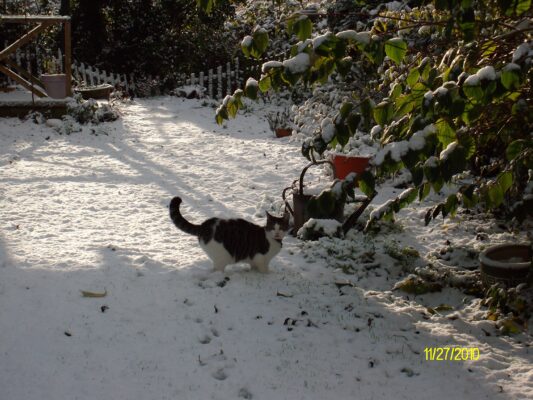
Signs of frostbite may take days to show:
- Swelling of any infected areas
- Pale, grey or bluish skin
- Blackened or necrotic (dead) tissue
- Pain when parts of the body are touched
- The affected areas are cold to touch
- Blisters
- Skin ulcers
- Red and inflammation as the frostbite thaws
The tissue will die from severe frostbite, and the skin changes from bluish to black, eventually falling off and leaving pus or a stinky smell from infection. The outcome depends on the extent of severity. Severe frostbite causes disfigurement, and extreme can result in amputation.
Helping to keep your cat safe outdoors:
Keep your feline indoors during the hottest part of the day. Heatstroke prevention is needed indoors too by keeping curtains closed to stop the sun from heating a room. Providing extra bowls of cold water is needed to keep your feline refreshed.
Ensure your cat has shade in the garden and access to clean water.
Never risk cancer – invest in sunscreen. Aniwell is suitable for horses and dogs too.
Keep your cat indoors during freezing temperatures, especially at night. Help stray cats by creating a warm shelter off ground level with bricks, put in a sheltered corner of your garden, insulating it with hay (about £3.49 from QD Stores) and offering food and water.
9 – Hayfever
Cats love to sleep beneath bushes and shrubs, and in rural areas, alongside wheat fields, nestled within tall grasses, or curled up asleep on overgrown verges adjacent to their home and fields. But pollen can bring on an allergic reaction.
Cats can develop allergies from outdoor irritants during the spring and suffer from skin issues instead of common sinus problems humans suffer from.
Itchy skin, ears and bottom, and bald patches around the groin, tail, lower back, and paws are indications but signs must not be confused with a flea allergy. It is essential to ensure your cat is up-to-date with its flea treatment. Signs of a skin irritant in cats are biting, scratching, and licking which can cause fur loss.
Hayfever in cats is severe and a veterinary appointment is essential. Your vet may prescribe an antihistamine or anti-allergy vaccine following tests.
Helping to keep your cat safe outdoors:
Preventative measures from your vet might be evening primrose oil, an anti-allergy injection or antihistamines.
10 – Injury from catfights
Some cats will likely protect their territory and/or a family cat from a neighbourhood cat who bullies. I wanted to include this topic because cats can suffer catastrophic injuries from a simple catfight, all because of an obstacle around them.
Joey died aged 13. His vet spent three hours trying to save him, initially consisting of blood tests for poison. The tests were negative. She had ready medication to give him for the seizures.
The final diagnosis was he’d probably hit his head during the catfight (the fight occurred between our parked cars on the drive). The seizures were ongoing and caused more brain damage. Joey lost his eyesight, and eventually, my boy couldn’t stand, and I had to say goodbye.
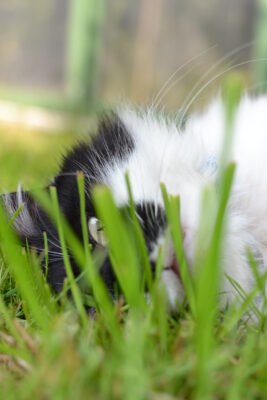
Helping to keep your cat safe outdoors:
Again, you can’t be beside your cat every moment, but if you notice something wrong, get your cat to a vet quickly. For Joey, he hit his head in the wrong place and the outcome was his death.
11 – Outbuildings, sheds, garages and greenhouses
Cats are curious, get into outbuildings, and are notorious for remaining unseen. Sheds and greenhouses can heat up and be fatal. A new neighbour moved in next door to me and found the remains of a cat in the garage.
Sheds and outbuildings are filled with lots of stuff that a cat may sleep amongst, and when we lock up at night, we don’t all think about whether a cat is inside. Cats trapped inside outbuildings are a concern during good weather-we start gardening because the weather is better, doors are open and cats creep in …
I never stored much in my last shed, so I could always check quickly. My shed in Norfolk was huge, and although tidy there was always a chance of a cat hiding and getting trapped inside. So my ex-husband fitted a cheap cat flap to the side door and we tied it open (there’s always a cat that doesn’t know what a cat flap is for), and I always left a bowl of water inside too.
Helping to keep your cat safe outdoors:
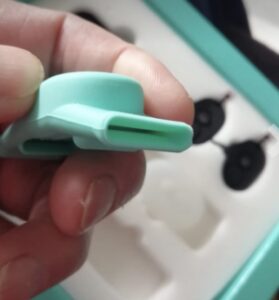
TabCat can find your cat in outbuildings and as close as 1″ using a directional handset comprising of lights and sounds, as long as the homing tag is attached to your cat’s collar. You do not need a Smartphone to use this device.
If your cat doesn’t come home, get leaflets printed asking homeowners to check their garden sheds, outbuildings, greenhouses, and put them through letterboxes on your road and several roads on either side. You can display posters outside but remember we sometimes walk along oblivious to what’s around us.
Key takeaways
- Cats hide signs of feeling unwell, unless physical, or maybe loss of appetite, biting
- You can’t stop your cat from coming into contact with toxins if it roams freely
- You can monitor or find your cat with a tracker
- Veterinary intervention may save your cat’s life and future medical bills
- Cats do not necessarily have to eat poison but can get poisoned by walking in it, brushing past it and ingesting it when cleaning themselves
- If you suspect toxicity, make sure you give a vet all necessary information (when, where, what, the time) or as much as you can
Related questions
What reputable firms offer cat-proofing and catio?
I’ve suggested cat-proofing your garden or installing a catio several times – it can keep your cat safe.
ProtectaPet is recommended by a well-known magazine and provides balcony enclosure, catios, fencing, fence toppers and commercial fencing.
Alternatively, Felisafe is affordable and customer friendly and sells custom cat fencing. It is DIY-friendly, can be fitted onto sheds and outbuildings, and is easy to install.
A catio comes in various designs and is fitted adjacent to your house, considering the location of windows and doors. Size is optional and can be styled into a ‘room’ with enrichment, shelter, comfort, safe plants and refreshments for your feline – you can include seating for you too, depending on the size of the catio.
Any of these minimises the risk of danger outdoors.
What does a seizure look like?
A seizure is a fit and abnormal brain function, depending on the cause. As Joey did, a cat laying on its size will ‘paddle’ with its legs. In other words, it resembles a cat running whilst lying down. Other behaviours are twitching, loss of control, defecating, loss of consciousness and collapse. Fits cat be singular or become more frequent, lasting for minutes or hours. A vet should be contacted at the first hint of a seizure.
In Memory –
Joey, Muffin, Dixie and PJ – very much missed
Poppys Pets is a participant in Awin and Amazon Associate affiliate programs which compensates me for referring traffic. It is of no extra cost to you and if thinking of buying a product, please consider using my link. It\'ll earn Poppy\'s Pets a few pennies to continue to this website. Only a selection of articles and videos on this website and YouTube channel contains affiliate links. Further information: Disclaimer and Privacy Policy
Poppy’s Pets has a pet niche column in the Withernsea District & Community News


